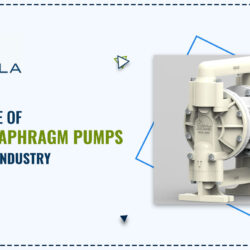High-viscosity fluid management has various challenges in industries ranging from petroleum to food processing. Understanding the characteristics of these liquids and selecting the appropriate high-viscosity pump is critical for operations. AODD pumps are used in industries because of their ability to handle a wide variety of fluids including those with high viscosity. However, fluid viscosity can have a considerable impact on pump performance and efficiency, posing a variety of operating issues. Understanding these problems and developing appropriate solutions is critical for increasing the efficiency of air-operated pumps in handling high-viscosity fluids.
Key Issues With AODD Pumps and Solutions To Them
Reduced flow rates
High-viscosity fluids are more resistant to flow than low-viscosity fluids. This resistance might cause lower flow rates through the pump system. Air-operated pumps which use compressed air to move diaphragms and transfer fluids may have slower flow rates when dealing with viscous fluids. This can result in decreased efficiency and longer processing times which reduces overall output.
Increased friction and wear
Viscous fluids can produce more friction between pump components resulting in increased wear and tear over time. Friction can harm the pump’s diaphragms, valve seats and other moving elements potentially shortening their lifespan. Increased wear needs more frequent repair and replacement, raising operating expenses.
Priming Difficulties and Self-Priming Capability
Fluid flow is necessary for air-operated pumps to retain their self-priming and priming capabilities. High viscosity fluids can make it difficult for the pump to prime at first or to keep prime while operating. This priming challenge may result in ineffective startup procedures and disruptions to fluid transfer operations.
Risks of Cavitation
Fluids having a high viscosity can make the pump more susceptible to cavitation. Cavitation is the result of low pressure at the pump inlet creating vapour bubbles that burst within the fluid, damaging the Air Operated Diaphragm Pump’s internal parts and decreasing its efficiency. When using air-operated pumps with very viscous fluids, controlling the risk of cavitation becomes essential.
Ways to Improve the Performance of Air-Operated Pumps Using High-Viscosity Fluids
Do Choose the Proper Pump Design and Components
It’s important to use air-operated pumps made especially to handle fluids with high viscosity. Robust diaphragms, strengthened valve seats, and materials resistant to corrosion enable pumps to minimize wear and tear and handle the challenges presented by viscous fluids. Enhancing flow rates and efficiency can also be achieved by choosing pumps with wider internal passageways and lower internal friction.
Try To Increase Air Pressure and Supply
The performance of air-operated pumps can be improved by appropriately sizing the air supply and modifying the air pressure in accordance with the viscosity of the fluid being pumped. By helping to overcome the resistance that viscous fluids present higher air pressures can help maintain constant flow rates and ultimately increase overall pump efficiency.
Consistent maintenance and observation
To increase the longevity of air-operated pumps that handle high viscosity fluids a proactive maintenance strategy must be put in place. Unexpected downtime and expensive repairs can be avoided with routine inspections. Besides that lubrication of moving parts and prompt replacement of worn-out components. Early indications of wear or inefficiencies can also be found by keeping an eye on pump performance indicators including temperatures, pressures, and flow rates.
Please get in touch with us if you want to buy the best quality AODD pumps or need any guidance on pumping high viscosity!

Nirmala Pumps & Equipments
Nirmala Pumps & Equipments is an Indian company that manufactures and supplies pump systems, valves, strainers, and pneumatic pumps since 1989. We provide services to different industries, both domestically and internationally, such as citrus, distilling, wastewater treatment, and petroleum.








